Researchers at Portland State University have completed an evaluation of Portland’s cycle track on SW Broadway and buffered bike lanes on SW Stark and Oak. The analysis, prepared for the Portland Bureau of Transportation (PBOT), shows that both of the bikeway types are “working well,” but PSU also laid out some recommendations on how to make them work even better.
Using a combination of road user surveys, video footage, and PBOT data, researchers Chris Monsere, Ph.D. P.E. (Civil & Environmental Engineering), and Nathan McNeil and Jennifer Dill, Ph.D. from the PSU Center for Transportation (the same folks who evaluated the bike boxes for PBOT last fall) compiled detailed information about how the bikeways were being used by people on bikes, on foot, and in cars.
The evaluation has some fascinating nuggets of information:
Cyclists expressed support for the cycle track. Over 70% of survey respondents indicated that the cycle track made cycling on SW Broadway safer and easier… Furthermore, motorists generally disagreed with the sentiment that the cycle track made driving less convenient or that it takes longer to drive this section of SW Broadway now.
Motor vehicle delay is still low after removing one travel lane… PBOT has received few complaints about traffic on SW Broadway (only four traffic-related complaints in the comment log). No issues with parking were identified as a long-term problem.
97% of cyclists are using the cycle track rather than the motor vehicle lanes (prior to the installation of the cycle track, 12% of riders “took the lane” instead of riding in the old bike lane).
Cyclist understanding of and compliance with the traffic signals on SW Broadway is poor… Many cyclists expressed confusion about whether they needed to stop or stay stopped in the cycle track on a red signal indication. Consistent with the survey findings, only 56% of cyclists observed in the video review stopped during the red signal phase (though this is consistent with only 59% of observed cyclists stopped during the red signal before the cycle track was installed). Thus, it is likely that the lack of compliance is related to the lack of conflicting traffic rather than the cycle track design.
Cyclist use of the left-turn boxes could be improved.
Cyclist and pedestrian conflicts are high… Over 40% of cyclists stated they had been involved in a near-collision with a pedestrian, while 12% of pedestrians stated they had been involved in a near-collision with a cyclist.
Loss of curb access presents a challenge to physically handicapped persons.
In a summary, researchers said “overall… the SW Broadway cycle track is working well.” However, they recommend improvements to reduce conflicts between people walking and biking. These include a bike-only traffic signal, a “wait here on red” stencil in the cycle track, improved crosswalk markings, and more.
The researchers also found that the buffered bike lanes on Stark and Oak are “working well.” They also explored two main areas where they could be improved. Since the wide lane looks like a standard vehicle lane, the researchers recommend that PBOT considers additional marking and signage including more bike stencils and overhead lane control signage on traffic signal arms.
Researchers also identified right turns at intersections without a right-turn lane as a “key conflict area.” To remedy that, they recommend creating a right-turn lane by removing some curb parking, shifting the bike lane over, and re-striping in the manner shown below…
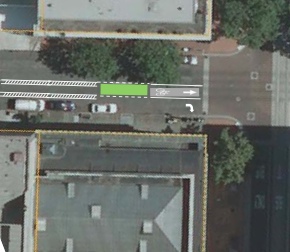
New PBOT Director Tom Miller is a proponent of separated bike facilities, so you can bet he’ll use this evaluation to inform decisions in the future. Give it read for yourself by downloading a PDF of the entire report here.
— Researchers Chris Monsere and Nathan McNeil will present this evaluation at a free seminar at PSU tomorrow titled, “Portland’s Cycle Track and Buffered Bike Lanes: Are they working?”


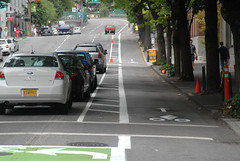
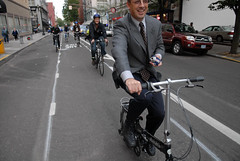

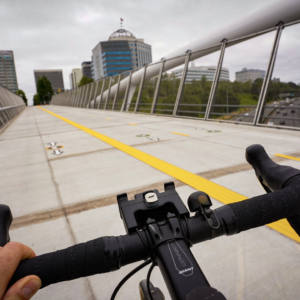
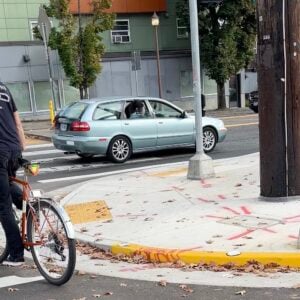
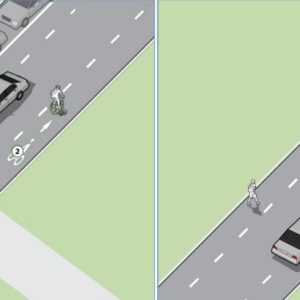
Thanks for reading.
BikePortland has served this community with independent community journalism since 2005. We rely on subscriptions from readers like you to survive. Your financial support is vital in keeping this valuable resource alive and well.
Please subscribe today to strengthen and expand our work.
I really think buffered bike lanes are the way to go. That said, I think we can do more to educate all roadway users.
I’ve seen a bit of motor vehicle traffic in the Oak/Stark buffered bike lanes, both moving and stopped. This includes a City of Portland van that was blocking cross-traffic as the signal began a yellow phase. The van entered the bicycle lane and continued in it for two blocks before turning right on 3rd ave. No conflicts that time, but it would certainly qualify as an unexpected event for anyone entering the bicycle lane, or anyone trying to park.
I was told that buffered bike lanes can’t happen even with loads of grant money to improve North Bound Williams. There are many fake excuses to condemn cycle tracks.
Former BTA staff now making money as Alta Planing consultants are trying to down play cycle tracks in public meetings. Michelle Poyourow said the PSU cycle track works because it is an experiment, with no bus stops. The truth is that there is a bus stop and it works extremely well. The bus stop on the 3rd block of the PSU track. The bus slows, down, pulls right, stops, fits fine. People leave the curb, walk over the bike lane, and board the bus. Happens several times an hour. I’d say about 120 passengers on & off each hour. That’s more busy that most bus stops I’ve ever seen.
Disabilities? I keep hearing bike projects blamed for hindering ADA accessibility. I’ve never heard any details or one compliant. Vehicles with lifts work fine with cycle tracks.
There is no reason why some of the big money for the N. Williams project can’t start a 3 block cycle track project. Come to the meetings.
http://bikeportland.org/2010/07/12/alta-wins-contract-to-develop-portland-bikeway-projects-36433
I don’t mind sharing the Stark/Oak buffered lanes with turning traffic, so long as they enter the lane right at the turn. Way too many drivers go a block or two in that lane before turning.
OTOH these are pretty low traffic streets so it’s seldom stressful.
I wonder if the bike-specific signals on the broadway cycletrack could be just be a “cyclists yield to pedestrians” light during the motor vehicle red phase. In other words, you may continue through the intersection as long as you yield to people walking. Realistically, that’s the most that many riders will do. The danger of running those lights when there are no pedestrians or streetcars present is near zero so the temptation is understandably high.
Or, rather than introduce a new type of signal (the “cyclists yield to peds” light), just give cyclists a FLASHING red during the motor vehicle red phase, essentially turning it into a stop sign. That would mean that everyone would have to stop but cyclists, after yielding to anyone crossing, could continue on before all the lights turned green.
I don’t see a compelling reason to encourage that sort of traffic conflict when it’s easier to be consistent and just enforce the red light.
although the report concludes, based on the fact that the before and after noncompliance numbers are similar, that noncompliance with the signal has largely to do with the fact that there is no cross traffic, the fact is that the signals are over there on the travel lanes and nowhere near the cycletrack. simply putting an additional signal on the cycletrack would probably improve compliance.
in all honesty, it is not obvious that a completely separated facility is controlled by the same signal. for example, as you climb the sidewalk north onto the broadway bridge eastbound, do you stop for the light? unless there are cyclists entering from lovejoy, i would guess most cyclists would answer “no.”
The light on the Broadway viaduct at Lovejoy (http://bit.ly/fmv8cd) is a perfect example. Do you stop there on the bike path when traveling north on Broadway, Paul? I’m legitimately curious.
The difference between the Broadway example and viaduct example is that Broadway’s cycletrack functions as a buffered bicycle lane, whereas the cycletrack on the viaduct is physically seperated by a barrier creating a second roadway.
Here’s the compelling reason:
A situation where one can frequently and safely ignore a stop light (as cyclists can northbound on Naito, on the Broadway cycletrack, and on NE Multnomah at 3rd) contributes to decreased compliance at lights that cannot be safely ignored (i.e. most everyplace else).
It’s essentially a traffic control device crying wolf.
This is a lot like the argument for Idaho Stop: we shouldn’t design our streets to create scofflaws out of safe, reasonable people. I’d rather not commit over $2,000 in stop sign violations every day on the way to work, but I’ll continue to do it because it makes sense, it’s safe, and experience suggests I won’t get caught.
Is that the kind of attitude we want people to have about our laws and our infrastructure? I certainly don’t think so.
this argument would have merit if there was evidence that treating traffic signals as a yield was unsafe. 20+ years of the idaho stop suggests otherwise.
You mean 6 months. The Idaho Stop hasn’t been legal that long.
Never mind that northbound Naito has frequent intersections coming from the right with cycleway connectors to the Willamette Greenway. I, for one, don’t appreciate nearly getting blindsided because some loser can’t be arsed to stop on red for cross traffic.
You mean 6 months. The Idaho Stop hasn’t been legal that long.
I’m confused by this statement. The Idaho Stop Law passed in 1982:
Did something happen six months ago that I’m not aware of?
Exactly, Paul. Those idiots have concluded that, because the signals are primarily designed for cars (correct), they can completely ignore them (incorrect).
There would likely be better compliance if we asked people to do something that seems more reasonable, like YIELD.
Those idiots are not YIELDING, Paul. Portlanders, it seems, can’t handle the “yield” concept (perhaps because there doesn’t seem to be many yield signs here). They want a binary, black/white system of stop/go, my turn/your turn.
Life’s not that simple and street design and expectations shouldn’t be either.
The turn lane is an interesting proposal. I’m curious to see the presentation tomorrow at the PSU Transportation Seminar; maybe we can get some discussion going on that.
Personally, I’d be more inclined to ban right turns except for bikes on roads with buffered bike lanes.
ie, if you really wanted to turn right, well, you should have planned that out in advance and brought the right tool for the job.
as in:
Two wrongs don’t make a right, but three lefts do!
good luck getting the city to remove enough parking spaces to ever make this a reality.
I’m glad to see that the Bway Cycletrack and wide/buffered bike lanes are getting the official thumbs-up.
I’d like to see the “wide” bike lanes striped as “twin” bike lanes of 5′ each in places. With paired stencils–side by side. Then it’s the same recognizable proportions as a conventional bike lane that motorists see all over the city and they won’t get so confused. And slow bikers can keep to the right, fast ones to the left.
Kinda like the short section on the Madison Bridge at Grand (as you’re on the approach to the Hawthorne Bridge).
Higher capacity, higher speeds overall, fewer bike-bike conflicts.
Ted Buehler
I like the dual lanes idea. I’ve been frustrated a few times trying to pass a slow rider that meandered and took up the whole lane.
Move to the next lane when passing, lane splitting, even in the circumstances allowed, is dangerous and bad form on bicycle facilities.
how are you supposed to get to the next lane when there is a line of parked cars in your way
You don’t. The cycle track ought to be striped with two lanes, reduce the pedestrian margin on the door zone down to one foot.
you make your move a block or two early. the cycletrack is intended for use by people who are not comfortable riding among motor traffic. yet another reason we need clarity on the mandatory sidepath issue — not only a repeal of the statute, but a persistent education campaign that lets motorists know that cyclists do not “belong over there.”
In Vancouver, BC, Canada the new downtown separated bike lanes are two-way. This seems odd at first but you get used to it in seconds. In practise it means that when there isn’t someone approaching you can use the other direction as a passing lane.
Another good thing they have is a cement barrier between the bike lane and the car lanes. Where there is expected pedestrian crossings (where the bus stops and loading zones) the pavement on the bike lane ramps up to the cement level height. There are signs for the cyclists and the pedestrians to watch out for the other but cyclists must yield to pedestrians.
On some streets there are separate traffic lights for the bike lane. The cars turning right get an advance turn, which is followed by the bike lane and the pedestrians. It works very well once people are used to it.
The first two weeks they were in operation they had flaggers at each intersection reminding people and helping them know how it works and what they should do. They must’ve been specially briefed because they were all very friendly and bubbly.
On some blocks the barriers have planters with flowers, others they have a long row of bike racks. The parking meters will eventually be moved out from the sidewalk to these barriers I think.
I’ve found a Flickr set with pictures of the new lanes.
http://www.flickr.com/photos/pwkrueger/sets/72157625160007617/
Lane against a general traffic lane needs to be 6′, but a bike lane that is against another bike lane in the same direction can be 4′. The closest to what you’re asking that’s possible under existing engineering standards is 6’/4′.
I’ll add that there are several storm drain grates (Type1 or (W)rectangular Roulettes) right next to curb cuts (@ Hall, Harrison, & Montgomery) that are too small for their inlets, and might catch a bike tire (in line with traffic):
http://www.flickr.com/photos/ufobike/5391804743
or Wheelchair caster wheels:
http://www.flickr.com/photos/ufobike/5389153173
I’m told that they can’t replace the grates because they don’t have any that fit, so they’d have to rip out the drains and replace.
Seems to me that they could just weld some material to a type 2 grate (an ADA compliant design) to make them fit in the larger hole (they are too narrow otherwise).
http://www.flickr.com/photos/ufobike/2908537897
I am an 11 year commuter on that stretch of Broadway and I am one who disagrees with the majority of the folks who took that survey. I have had more near miss incidents mainly from unaware pedestrians in the last year or so than in my entire 11 years on commuting on that stretch…
good point. Those 3 blocks have thousands of people crossing the bike lane each hour in working hours. It’s mostly PSU students going to/from buildings on both sides. I doubt cycle tracks in other locations would have such high numbers of pedestrian near misses. Is there any record of a bike-ped crash on this 3 block cycle track? If yes, who was moving on the red light?
I vehemently agree. I had very few conflicts with motor vehicles in the bike lane on this stretch of Broadway prior to the cycletrack. (The hotel zone is another matter entirely.) I now have near daily conflicts with oblivious (or hostile) pedestrians. Moreover, the cycle track was reasonably clear in 2010 but is now increasingly blocked by shuttle buses, taxis, and drop offs. This might seem like a minor issue but it forces me to squeeze through parked cars to take a travel lane. Frankly, this is the least favorite part of my commute and has caused me to reconsider my support of dedicated cycle tracks. A cycle track that does not fence in cyclists (or a buffered bike lane) would have been a far better solution, IMO.
The hotel zones needs a permanently stationed parking enforcement officer with a nearby tow truck.
i bike to psu daily and love the cycle track. as commuter said there are more oblivious pedestrians now but it beats the hell out of oblivious drivers down by all the hotels.
i usually get onto broadway by the schitz so i am fortunate enough to avoid the hotels…
I occasionally have to go around cars parked in the cycle track and I wish there was a more efficient way to make pedestrians and cars dropping off passengers aware of the cycle track.
What exactly do you think is an improvement over the original bike lane? I had an initial positive reaction (the wow a new dedicated facility warm fuzzy feeling) but I now find this facility to be more stressful than the previous bike lane.
the improvement is i’m not terrified of being right hooked. either by cars turning right (which i realize isn’t gonna happen as the campus disallows this) or by people parking. i have stopped taking broadway after i cross burnside (most days). i cut west a few blocks. i had daily near misses by right turners, parkers or people in the hotel zone just not paying attention at all. and if i didn’t have a situation personally i would see one happen to a cyclist ahead of me. daily. i’m not exaggerating. i hate broadway. well, not exactly. i think it’s a beautiful street to look at if you’re strolling down the sidewalk, but for a good chunk of the day people have their heads too far up their asses to make it worth biking on.
Seen a lot of people cut through the cycle track at the top to pass people in the middle lane before the 405 overpass when cars are not parked in the spaces. I really think a mild curb between the lane and the track would be a good idea.
when I say people, I mean people in cars.
“Loss of curb access presents a challenge to physically handicapped persons.”
oh, bummer. i am sensitive to those who face physical challenges, and recognize ADA access often benefits more than the disabled (like, say, curb cuts!). i hope there is a solution to this.
I’m thinking this is a minor issue since people accessing their car should be using the pedestrian margin to get to the nearest crosswalk to cross the cycletrack anyway. Handicapped users, unfortunately, end up with this enforced by the equipment on hand, however, so this puts them at a relative disadvantage to able-bodied pedestrians that just jaywalk across the cycletrack.
The law has been on the books 28 years.
I was thinking if Missouri and Oklahoma which passed them last November. Three states that don’t have cyclists doesn’t a good bike policy make.
What are you talking about Paul? Idaho passed their law in 1982. In Oregon we never passed it.
I think it’s the Californian influence working against Portland on this one. Yield signs used to be much more prevalent, but after the Californian influx in the 1990s, these signs became increasingly ignored. Compare Clark County, Washington, which has a relatively high Californian transplant population, to Tulsa County, Oklahoma, which has next to none, and driver behavior at yield signs on freeway entrances. The yield sign might as well say “ram the guy who has right of way off the road” in Clark County, whereas people generally slow down or stop until there’s a suitable gap in Tulsa County.
Right hooks are actually not a problem on Broadway by PSU since there isn’t really a road to turn into. If you go up a few blocks past PSU, the risk of a right hook I think is even greater since cyclists are blocked by parked cars while riding in the cycle track which makes them less visible to drivers and ultimately if there is a truck or large vehicle parked right at the corner of a turn, you are less visible and more likely to get unintentionally right hooked. So for me as a cyclist, not only do I have to watch for inattentive pedestrians, I also have to look through a barrier of parked cars for potential cars turning right. As someone who has been commuting for more than a decade on this stretch of Broadway, the number of potential ‘hazards’ that I have to look out for has increased on this stretch.
I always take the lane there because cars are not looking for continuing cyclists and the row of parked cars make cyclists practically invisible.
the idaho statute, 49-720, has been in place since 1982
not at the intersection in question. there is a curb cut, which cyclists coming up from lovejoy in particular but also pedestrians use
That would be a merge point, since the cycleway is one-way and the gap in the barrier angles downstream.
whatever, dude. my point is if you want cyclists to stop at some intersection on the south broadway cycletrack, you ought to put a signal over here, rather than expecting people to guess that some signal over there applies to them.
I’m not arguing against that, it would aid in clarity. I am saying that if you have difficulty reading a traffic light, you shouldn’t be operating a vehicle.
Likewise if you’re unable to tell what roadway you’re on.
incidentally, i think it is interesting that with respect to the buffered bike lanes, monsere and dill recommend the very same treatment — a designated space through which right-turning motor traffic should merge across — that PBoT has resisted with respect to ordinary bike lanes.
K’Tesh wrote
“I’ll add that there are several storm drain grates (Type1 or (W)rectangular Roulettes) right next to curb cuts (@ Hall, Harrison, & Montgomery) that are too small for their inlets, and might catch a bike tire (in line with traffic):
” http://www.flickr.com/photos/ufobike/5391804743
“or Wheelchair caster wheels:
” http://www.flickr.com/photos/ufobike/5389153173
“I’m told that they can’t replace the grates because they don’t have any that fit, so they’d have to rip out the drains and replace.”
K’Tesh — have you sent these photos in to safe@portlandoregon.gov? They’re out of compliance with the Oregon Bicycle and Pedestrian Plan’s Facility Design Standards. Section D.1 “Drainage Grates” (Page 73). http://www.oregon.gov/ODOT/HWY/BIKEPED/docs/or_bicycle_ped_plan.pdf?ga=t
Ted Buehler
I went to the seminar today, I thought they did a fine job of assessing how well the different new bike facilities were functioning.
Thanks much to PBOT and the Mayor’s Office for demonstrating to Portland and the rest of the country that these are good, functional designs for bicycle facilities. I expect that they’ll eventually be added to the MUTCD (or its successor) so that we’ll be able to ride in facilities like this in many cities around the country.
Ted Buehler
to all the comments above: TL;DR
As someone who has a multiple daily interactions with the cycle track, I think a good way to reduce cycle/ped incidents would be to put someone at each intersection with a club and clobber all the peds who take two steps out and then stand in the middle of the cycle track texting while waiting for the light to change. Failing physical abuse, an additional signal would be clearer, but a lot of the time people on bikes seem to just slow down and find a way through the hordes of college kids when the light is red. It’s more of a woonerf situation than a running the red into dangerous cross traffic situation, and it’s unfortunate that there’s not really a good way to make this work in our present traffic control regime.
I should not find that funny but I do.
“a “wait here on red” stencil in the cycle track”
Its sad that the report called for markings directed at cyclists when in my experience the main conflict is caused by pedestrians and vehicles blocking the cycle track.
The fact that 30% of respondents did not have a positive attitude to the cycle track is hardly a glowing endorsement of a shiny new bicycle treatment. I strongly suspect that there was quite a bit of self-selection. (I was solicited for a survey by an eager young person who was ironically blocking the cycle track last year…Grrrrrr.)
No, I hadn’t. But that could change…